Keep Calm and Carry Ohm
23/11/08 Day 10 - Jaipur
Keep Calm and Carry Ohm 23/11/08 Day 10 - Jaipur |
||
Breakfast this morning was another opportunity to sample exciting new dishes. A potato croquette the shape of a cricket ball called Aloo Bonda and a lentil and rice dish called Khichdi were both delicious. That wasn't all I ate of course. The usual dal sambar, idli, paratha, pakoras also filled my plate. To round it off nicely a bowl of Khir the super sweet cardamom infused rice pudding was just sublime. That was a good start to the day! We had an early 8:30am pick up today as our guide for the day, Paresh, met us at the hotel's reception. It was a beautiful day today and already felt as if it was going to be the hottest so far. Paresh said that it was actually a lot cooler today. It had reached as high as 38C only a fortnight ago! We were so glad we had timed our visit right. That type of temperature would be unbearable. |
Then at the Badi Chaupar crossroads we turned left and pulled over. At first I couldn't see why but that was because we were too close to notice that we were parked outside the pink city's most famous pink attraction, the Hawa Mahal. This reminded me of when we stepped out of Westminster tube station in London and Julie asked "So where's Big Ben then?" We were actually standing at the foot of it! It was the same today because to get a better view of this incredible structure we had to cross the road to the opposite side. |
We left the pink city through Joriwar Singh Gate and headed out of Jaipur on the road to Amber. As we sped past an amazing floating palace in the middle of a lake Paresh assured us that we would be returning for a closer look later so we could all stop trying desperately to get a photo out of the window! |
We were on our way to visit the famous Amber fort but our first glimpse was quite disappointing. High on a ridge we could see fortified ramparts and whilst being in an impressive mountain top location it didn't look like anything special. Fortunately it turned out not to be the main featured attraction but was called Jaigarh fort. It over looked and protected the citadel below. Our eyes then saw the spectacular sight of the Amber fort. |
Established by Man Singh I in 1592 the fort palace became the capital of his kingdom. Whilst being the ruler of his own domain he was also a general in Akbar's army. It was interesting to learn how the Mughal Empire ruled through its alliances with the chieftans and maharajis. During the 17th century the fort was expanded by Jai Singh I and much of what we see today dates back to this period. Strangely however, after all that effort, within sixty years they had moved the capital to Jaipur. |
This included an 11am curfew when they down trunks and trundle their way back home in Jaipur. |
| It added to quite an atmospheric scene, one that vividly brought the fort to life. I could easily imagine the pomp and pageantry of the emperor's procession with their colourful elephants, flag waving and trumpet blowing. |
| We stepped inside the large courtyard, Jaleb Chowk the former parade ground and waited for Rob and Carol to arrive. |
| The brightly painted elephants followed each other, tail to trunk, in packs of three, through Suraj Pol, the large sun gates of Amber Fort. They then continued in file to the far right corner where they off loaded their passengers onto a tall platform and then return back down the way they came with an empty basket. |
||
 |
It was obviously just a one way ticket not a return. Rob and Carol weren't long behind us. They got off their elephant without incident and joined us in the centre of the courtyard. |
|
There was a lot of work going on here. Once again women in colourful clothes were carrying supplies on their heads to various parts of the fort where the men mostly stood and watched. The entire fort appeared to be undergoing a make-over. |
|
Looking at photographs of the fort in the guide book one could tell immediately that the outside had been scrubbed clean. Pollution had left its dark mess on the walls and especially the several domes. They now look as good as they probably did when Jan Singh I cast his eyes over them. Although apparently the renovations aren't to everyone's liking. Some prefer the historical to remain untouched and they do have a point. Paresh began talking about the history of the fort, about the Kachhawaha Rajputs but I was too pre-occupied with my camera following the trail of the lady labourers to listen to him. |
| I don't know but the two co-existing was, as I said, most captivating. |
From here the scale of the Jaleb Chowk courtyard below could be seen. It was also the best viewpoint to appreciate the stunning scenery of the Aravali hills. We were undoubtedly in a spectacular setting. The great wall snaking its way up the craggy rocks and along the ridge was absolutely wonderful. |
"Look how steep it is. I wouldn't want to walk all the way around that. I couldn't!" said Julie. Paresh replied that some people have run the entire circuit in a race. All we could say back was "Bloody Hell!" To the north east corner of this upper courtyard was the location for the now familiar titled Diwan-i-Aam, the hall of public audience. The multi-columned pavilion was arguably not as inspiring as the one in Agra but the breathtaking views made it quite unforgettable. |
The architecture of the Sattais Katcheri was most exquisite; definitely drawn from the realms of fairy tale palaces. Despite being the fourth fort in four days it certainly wasn't a case of "if you've seen one you've seen them all". Amber fort had quickly become my personal favourite and we hadn't finished seeing all of it yet. "The best is yet to come" teased Paresh. |
We
were amazed at the meticulous work in returning the Amber fort to its
former glory. Everything looked so beautiful and as Paresh promised, there
was more to come. |
| Many forts say they have a hall of mirrors but none live up to the expectations but here in Amber we saw the real dazzling deal. |
| "Imagine the light of a candle," suggested Paresh, "how it would reflect a thousand stars" |
We had to be content with sticking our heads in through the doorways and creaking our necks to see the ceilings. We continued to the fourth, the last, and the oldest section of the Amber fort. |
| In the centre of the courtyard there was a small 12 column pavilion that Paresh called the Baradari. |
 |
Apparently this would be a meeting point where the king could mingle with his wives and concubines. It stood out like a glowing heavenly portal as the sun illuminated the marble arches and pillars. |
| We left the zenana through a set of narrow passageways emerging into a small inner courtyard. |
 |
This had such a feeling of a medina as we browsed around the small market stalls. The alleyway gradually brought us back down to the lower level of Jaleb Chowk. |
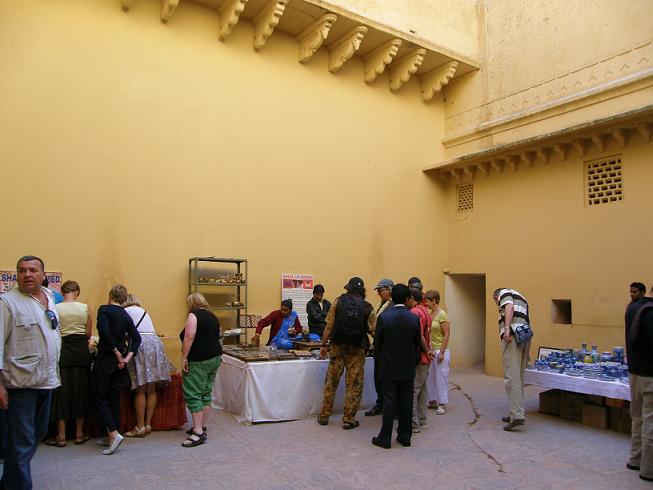 |
| I had been engrossed for over two hours of magnificent palaces and pavilions so I was disappointed that our Amber Fort visit was at an end. |
As we left the hills behind we reached the picturesque sight of Jal Mahal, a palace that appeared to be floating in the middle of the shimmering Man Sagar lake. It was built in the mid-18th century by king Madho Singh I and inspired by his childhood memories of time spent at Jag Niwas, the Lake Palace, in Udaipur. We pulled over so that we could get out and take some photographs. Apparently the lake is often dry during the summer months but the winter monsoon brings with it plenty of water to fill the lake and produce this gorgeous view. |
It wasn't that she had spoilt my perfectly framed shot, it was just that she turned out to be terribly unphotogenic. It would have been a great photo if she hadn't sulked her way across with such a stroppy face. |
Whilst we were on the topic of weddings Paresh said "This is a very auspicious time to get married, all the nine planets are aligned." |
Astrologists are held in such high regard in India and are consulted from the match making to the wedding dates to ... well ... practically everything. It's all written in the stars! In contrast the horoscopes in the UK are nothing more than a joke. Back on the bus we next had the obligatory shop stop with a visit to a gem store. Jaipur is renowned across India for its jewellery but the highlight of my personal visit was not the maharaji's treasure chest of emerald and rubies on display upstairs but the spectacular colour hair of one of the gemstone polishers downstairs. The outrageous carrot top look was achieved by dyeing the hair with henna which starts of jet black but over time it oxidises to this shocking shade of orange. It looked so hilarious and so inevitable I wondered why anyone bothered? |
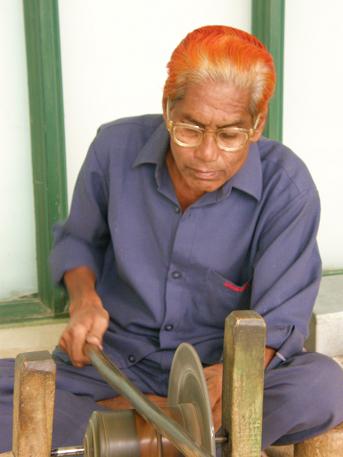 |
| We were on our way first to Jantar Mantar, a huge astronomical observatory built by an amateur astronomer who happened to be the king, Maharaja Sawai Jai Singh II. (He built five across India including the one in Delhi.) |
 |
We stopped first at the Laghu Samrat Yantra or small sun dial . "This shows the local time to an accuracy of 20 seconds" said a visibly impressed Paresh. | |
| We stepped up to the shadow cast by the structure onto the curve and it was very near the mark with the time being about 11:58am. | ||
I suppose we were looking at India's equivalent of Greenwich Mean Time, Jaipur's Sundial Time. |
| Another collection of instruments that require mention was called the Rashivalaya Yantra, a group of smaller replicas of the sundials but pointing in seemingly in random directions. |
| We spent some time locating our own zodiac signs of Gemini and Leo. Not that we believe in any of this astrology mumbo jumbo. | ||
 |
These instruments point towards their relevant constellations and are used for planetary measurements, the basis of all horoscopes. |
|
| It was fascinating to see the real science behind it all. It almost made you believe that there must be something in it. We had noticed that all the hotel's had an astrologer available for guests to receive readings. |
| Stepping out of the Jantra Mantra we could see the City Palace entrance was within walking distance so we followed Paresh across to the ticket counter and then through the tourist entrance which was nothing more than a side door. |
We entered into a large courtyard with a charming little palace in its centre. The Mubarak Mahal, also known as the Welcome Palace, was built as late as the 19th century despite looking centuries older. It had attractive scalloped arches and ornate carved screens. Inside however it was no longer a reception hall but a textile museum. I tried hard to find the tunics and saris worn by royals interesting but I couldn't hide my boredom as Paresh went to great lengths to explain each thread in detail. |
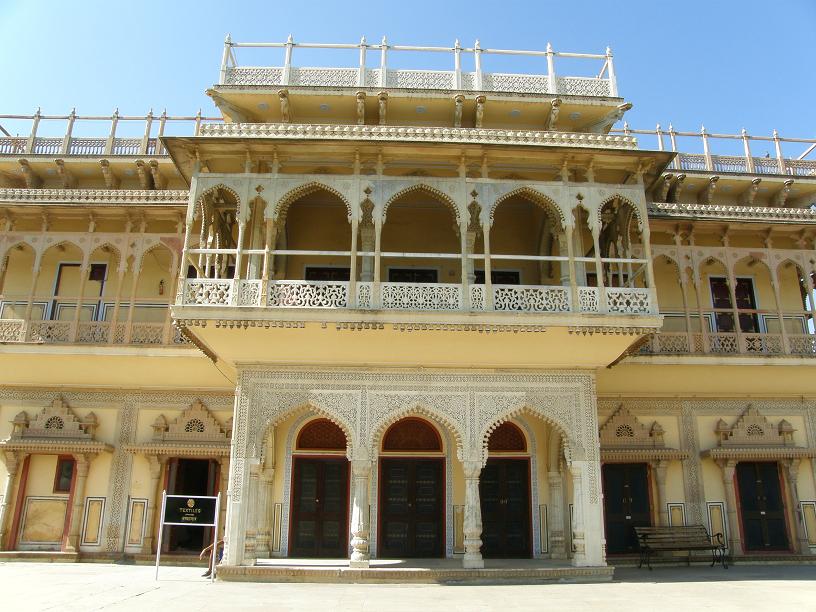 |
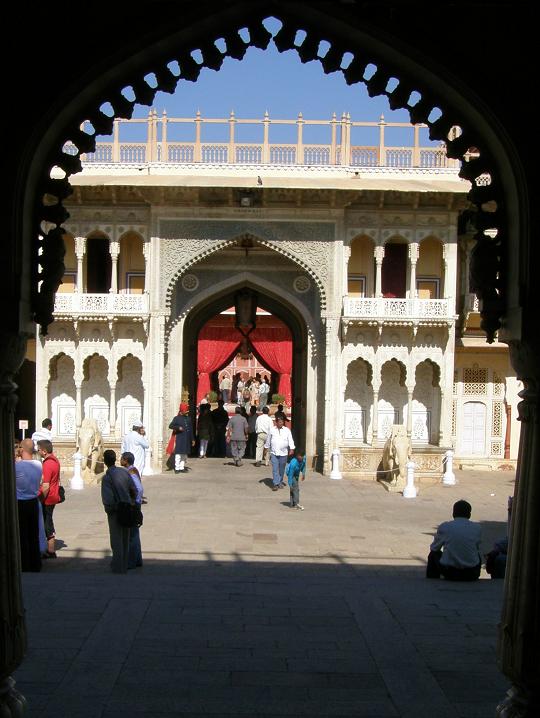 |
The tedium lifted the moment we stepped outside. Ahead of us was the imposing Rajendra Pol gate and despite the prospect of more textiles with red sashes of fabric further inside it all looked quite exciting. | |
| Within this courtyard was the Diwan-i-Khas, the hall of private audience and it was lavishly decorated with red curtains and the royal red carpet was laid out. | 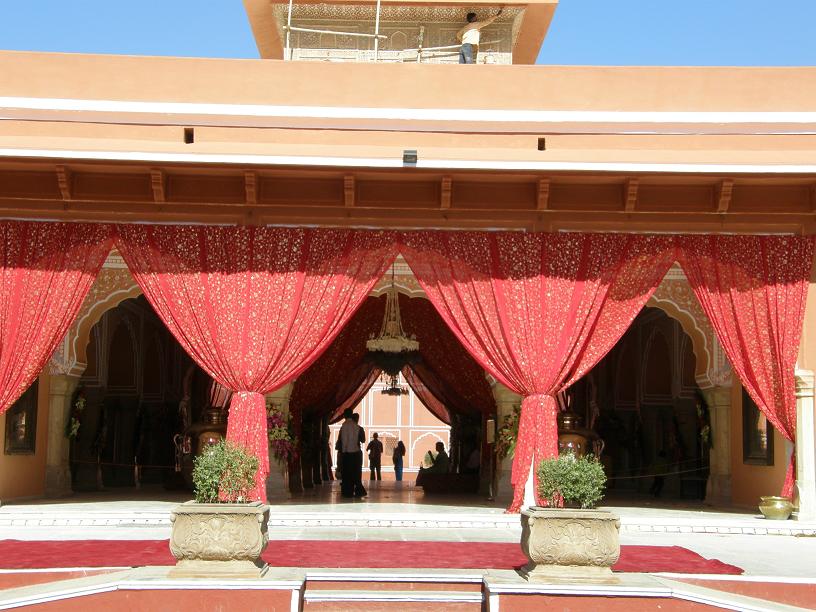 |
|
| They were busy in preparation for a wedding this evening. "It must be expensive to have your wedding here" said Julie. "Very expensive" confirmed Paresh "perhaps it is a Bollywood star" |
| Inside the pavilion two enormous silver jars took pride of place. On a visit to London in 1901 to see Prince Albert the Maharaja Madho Singh II took them with him having filled to the top with holy Ganges water. | ||
 |
What on earth was he thinking? It must have taken considerable effort to transport them over to the UK. |
|
I wonder what Queen Victoria though when the Indian prince arrived with these beautiful silver jars, only to siphon out the murky water and return home with his precious urns. It wasn't when Queen Victoria said "We are not amused" was it? |
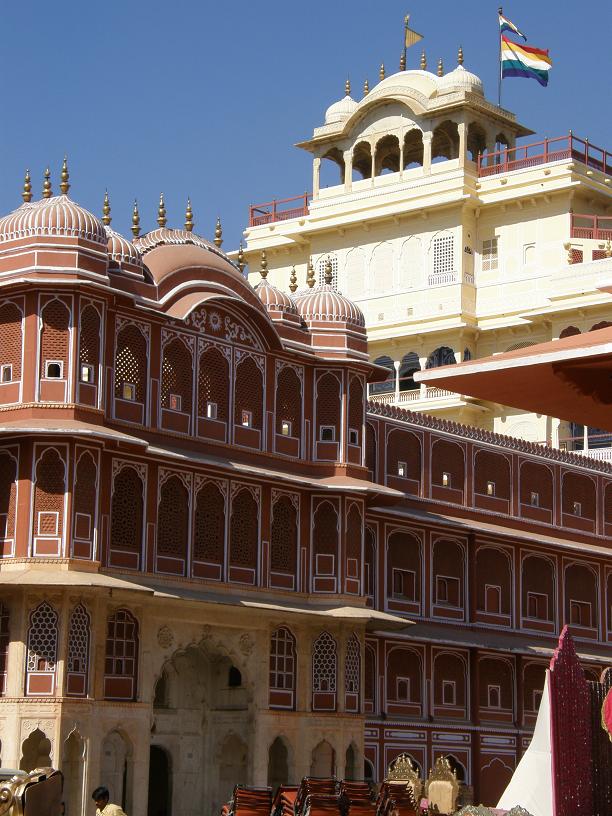 |
From the Diwan-i-Khas we could see the Chandra Mahal towering above all else. So we walked through a small archway with the funny sounding name Riddhi-Siddhi Pol. (It sounded like the "Ready Steady Go" gate!) |
|
We raced through and into yet another courtyard. This one went by the delightful name of Pritam Chowk, the court of the beloved. |
|
|
| We stood for a while looking at the many windows of the Chandra Mahal. We were hoping for a glimpse of a real life maharaja but we saw no one regal. |
| There
was an interesting video on a loop showing the visit of Lord Mountbatten
to the City Palace in 1949. At this moment in history he was no longer
the Viceroy of India as independance had already been achieved. The black
and white newsreel footage was intriguing as it clearly showed the pageantry
of a royal visit that probably hadn't changed in centuries. |
 |
Paresh told us that Madho Singh II, (the maharaja who brought the silver urns to London), was a champion polo player. He died in the saddle at the age of 72 whilst playing polo in the UK. |
|
We left the city palace through Udai Pol another highly decorated gate. The artwork in the alcove of a maharaja fully dressed in his traditional attire made this gate quite unique. There was a small canon on either side of the arch, a reminder of all the battles of the past. Although I think the maharaja's of Rajasthan were more masters of diplomacy as they held on to their power through alliances. |
||
|
It was in a hotel called the Hotel Sikaar Odi and was quite pleasant.
They had a large buffet on offer but we decided to go off the menu. Julie
and I are not the biggest fans of the old booffey. |
Yes, that's right, a real aluminium bucket. A small ornamental bucket, the sort you would pot some plants in. "I'm surprised they didn't give you a spade instead of a spoon!" joked Julie. Despite looking most unappetising Carol ate more than we expected. |
We left hoping we were on our way back to the hotel. Julie could hear the swimming pool beckoning but first we had the "bonus" of another stopping in a textile store. We were given a demonstration on how they block print the fabrics with vegetable dyes. It was bordering on being almost interesting. We went inside their very large shop and had a look around just to be polite. Unlike all the other forced shopping trips we actually bought something here. A couple of small prints of camels and elephants, a shawl and just as we were out the door he threw in a bargain we couldn't resist, 300 rupees for a large bedspread. |
| Off he went to check up on our credentials. I childishly pulled what I call my "mong-face" behind his back (don't pretend you don't know what I mean) and I felt much better for doing so. With hindsight I still think it was the better option, juvenile or not, as I was so close to telling him to "fuck off" and say "Don't you know who I am?" Anyway, despite that, we spent a lovely hour relaxing by the pool before returning to our room to get ready for the evening. |
| It was all done by eye. She had a pattern book to follow but it was done free hand. I suppose the stain on the skin was only temporary so if it wasn't perfect it would only be for a few days. | 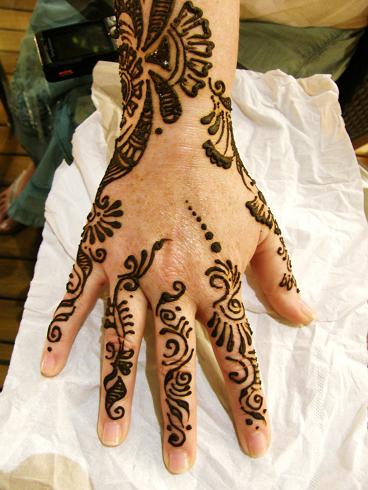 |
|
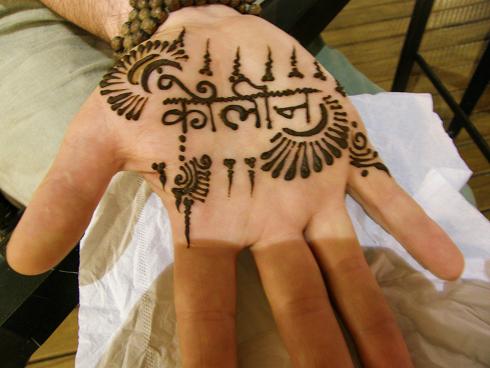 |
I was so impressed by the artwork that when she asked if I wanted a mehndi I was hook line and sinker in favour. | |
Instead of a girly pattern I had my name, or at least I hoped it was my name, scrawled across by palm. I did worry slightly that it could have said "tosser" or something equally as derogatory like camel shagger. The first thing I did when we returned back to the pool side bar was ask our bar tender to read my palm. He answered "Kholin". Either he
was part of the scam or Anyway, regardless of all that, I loved my beautified right hand, no matter what it said. |
We sat watching the poolside activity as the hotel prepared for this evening's wedding reception. The thrones were a particularly ostentatious touch. After last night's experience we knew not to sit here for three hours waiting for someone to turn up so we moved on to the bar area that fell off the main foyer. They had laid on some entertainment but to be honest it would have been better if they hadn't bothered. They were from Romania and went by the name of the Marius Duo. The name didn't inspire but at least they didn't have much to live up to. |
 |
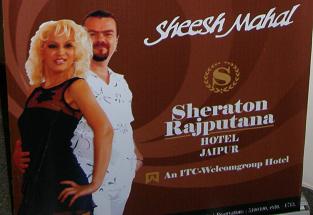 |
Now I pride myself on my eclectic taste in music, of my exceptionally broad spectrum of influences, from thrash metal Metallica to classical Andrea Bocelli and everything in between. If it's "good" then I can always appreciate something of a talent in any genre but these guys were awful, seriously shit awful. If you closed your eyes you'd think you were at a karaoke night in an asylum. How in the name of the goddess of music did they secure this contract? (Of course this my personal opinion and in no way represents the view of the Rajputana Sheraton and their associated tone deaf representatives) |
| We were just in time to witness the arrival of the groom on heavily decorated horseback. |
His following posse were just "going for it" with absolute abandon, dancing like there was no tomorrow. Their joy was contagious as we stood and watched the sheer exuberance of the wedding party. I don't dance but even I felt like diving into the middle of them throw my hands in the air and frenetically jumping for joy. It was such a wonderful experience to be amongst the celebrations. |
|
We returned inside where the Romanian wailing was continuing in the lobby bar. The Eurovision song contest came to mind, "Good Evening Bucharest, this is London calling." Our score for them would definitely be a "nil pwa". |
It was a little later than usual but now was my favourite time of the day, supper time! We had a 10:15pm reservation at the hotel's Peshwari restaurant and were shown to the best table in the house, the one with a window onto the theatre of the tandoor kitchen. We ordered our choices and then watched attentively as the chef skewered huge chunks of paneer and placed them in the tandoor oven. He then scooped up a green mix for the spinach kebab and patted it tightly along the meter long iron skewers. Then finally he got a ball of dough, beat it out into a flat disc and then slapped it on the clay wall of the tandoor oven. |
 |
We ended the evening back in the lobby bar giving the atrocious duo another chance which they failed to take. Retiring to our room I soon drifted to sleep whilst Julie sat up watching a TV programme called "India's Best Weddings". |
| Next Day > | ||
|
ęCopyright 2000 - 2020 |